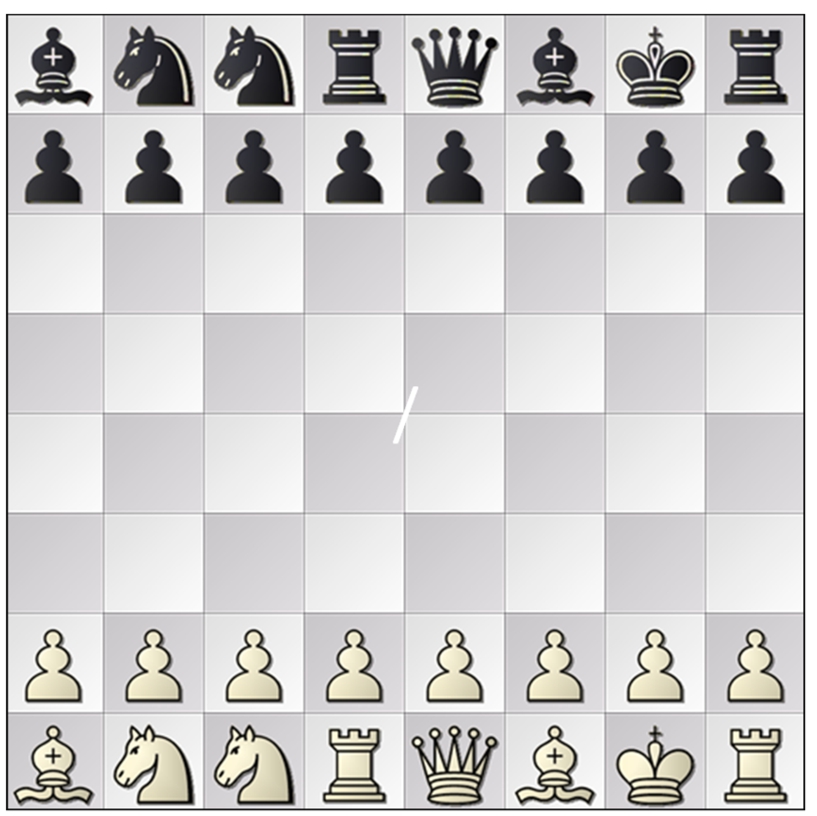Chess960 Superhumans!
Chess960 time at the Top Chess Engine Championship (TCEC, 2021a)! The more I watch these games, the more I feel that the gap between humans and engines is even higher in Chess960 than in normal chess. I loved the opening phase of this game between two of the less famous engines on show. I’m not sure I would have thought of any of Black’s moves! The game Vajolet2 – SlowChess Blitz is available for replay and download (TCEC, 2021b).
In common with most players, I always take a few minutes to size up a Chess960 position before I start to make moves! A first sweep through the position seems to indicate good and natural development prospects for the White pieces:
Ba1 – White will play either b3 or b4 to activate the bishop along the long diagonal (saving a move over the fianchetto in normal chess),
Nb1 – the standard knight development with c4 and Nc3 is obvious,
Nc1 – an odd place for the knight, but d3 is a good spot for the knight in a 1.d4 opening. So, the moves d4 and Nd3 also seem indicated,
Rd1 – the rook fits in well with any push of the d-pawn to d4,
Qe1 – as always, the queen can fit in with virtually anything. Here it is well-placed to support the e4 push after d4 to set up a double pawn centre,
Bf1 – the bishop can – as in normal chess – support a Queen’s Gambit type advance with c4,
Kg1, Rh1 – these are perfectly-placed to castle normally in one move once the bishop on f1 develops. However, since the king is already on the castling square g1, you might consider trying to achieve more with the rook than just moving it to f1. h4 and Rh3 comes to mind.
Fig. 1.
TCEC Season 20, FRC League B, 2021-03-05: Vajolet2 – SlowChess Blitz, Chess960 position #50 (Chess960, 2018; Scharnagl, 2004; Weeks, 2008; Wikipedia, 2021).

1.c4. My natural first move would have been 1.d4 but this is also perfectly reasonable. 1
This is the start of some remarkable moves from SlowChess! First, Black is alert tactically and keeps the knight on b8 ready to meet Nd5 (attacking c7) with
2
3.d4. White responds sharply, meeting wing play with central play. 3.h4 was also possible, preventing Black’s obvious play with
Fig. 2.
(a) position 3w, (b) variation position 4b, (c) position 6w.

7
The more I analysed, the more it seemed that Black was doing ok in this position. A large part of me rebelled against this idea: how could Black still be fine after playing all these odd ideas in the first seven moves (
Firstly, Black’s development was already pretty advanced from move 1! The black king was already ‘castled’ on g8, safe from any central dangers! Even more interestingly, the king could still castle to the queenside if matters got too hot on the kingside!
Fig. 3.
(a) position 7b, (b) position 8w, (c) variation position 10b.

Secondly, looking at the starting position of the black queen on e8, you see that it defends light squares such as g6 that would normally be terribly weakened by the moves
7
8.Rf4 attacking the f5–pawn, opening the diagonal of the dark-squared bishop and getting the rook out of attacks such as
11.Qc3, Fig. 4b. This looked very strong to me, introducing the violent threat of Nf6+
Beautiful! The key point is that Black threatens
Fig. 4.
(a) position 11w, (b) variation position 11b, (c) variation position 13w.

11
13.Qxb4 Rxe5 14.Bxe5 Qxe5, Fig. 5a. 15.g3. 15.Rxh4 e3, Fig. 5b, is suddenly rather fraught for White. This position could also be reached from 12.Qc3 Bxd5 13.cxd5 Nb4 14.Qxb4 Rxe5 15.Bxe5 Qxe5 16.Rxh4 e3. 16.Qd4 exf2+ 17.Kxf2 Qg5 threatening the follow-up
Fig. 5.
(a) position 15w, (b) variation position 16w, (c) position 17w.

15
The rest of the game is still interesting but less relevant to our theme. Black has a pawn for the exchange, a weak d5–pawn as a target and plenty of play on the dark squares. The game is approximately balanced and ended in a draw on move 80.
17.Bg2 hxg3 18.hxg3 Bf6 19.0–0 Rh8 20.Qe2 e3 21.fxe3 Bg5 22.Re1 Kb7 23.Bf3 Qf6 24.Qf2 Kb8 25.Bg2 Qe5 26.Rd4 Re8 27.Rd3 Ne4 28.Bxe4 Qxe4 29.Rd4 Qh7 30.Rg4 Rh8 31.Qg2 Bf6 32.Re4 g5 33.Kf1 Be7 34.Ke2 Bd6 35.Rc4 Re8 36.Kd2 a5 37.Rh1 Qg7 38.Kd3 g4 39.Qe2 Qg6+ 40.Kd2 Qf5 41.Rd1 Rg8 42.Kc1 Rg5 43.Qg2 Ka7 44.e4 Qe5 45.Kb1 Rh5 46.Qf2 Kb8 47.Re1 Rh3 48.Qf4 Rxg3 49.Qxe5 Bxe5 50.Rf1 Re3 51.Rf5 Re1+ 52.Kc2 g3 53.Rxe5 g2 54.Rg5 g1Q 55.Rxg1 Rxg1 56.Kd3 Re1 57.Rc3 Kb7 58.Rc2 Kc8 59.Kd4 Kd8 60.Rc3 d6 61.Rc2 b5 62.Kd3 Kd7 63.Rh2 Ra1 64.Rh7+ Kc8 65.Rh8+ Kb7 66.Rh2 a4 67.bxa4 bxa4 68.Kc3 a3 69.Kc4 Rd1 70.Rh3 c6 71.Rxa3 cxd5+ 72.exd5 Kb6 73.Ra8 Rc1+ 74.Kb3 Kb5 75.a4+ Kb6 76.Re8 Rh1 77.Rc8 Rb1+ 78.Kc2 Rb4 79.Ra8 Kc5 80.Ra5+ ½– ½.
References
1 | Chess960 (2018). https://chess960.net/wp-content/uploads/2018/02/chess960-starting-positions.pdf. |
2 | Sadler, M. (2021). https://matthewsadler.me.uk/engine-chess/chess960-superhumans/. |
3 | Sadler, M. & Regan, N. (2016). Chess for Life. Gambit. ECF Book of the Year. |
4 | Sadler, M. & Regan, N. (2019a). Game Changer: AlphaZero’s Groundbreaking Chess Strategies and the Promise of AI. New in Chess. ECF 2019 Book of the Year; Winner of FIDE’s 2019 Averbakh-Boleslavsky Award. See also tinyurl.com/1bi3w4sr and tinyurl.com/ym3a3f7d. |
5 | Sadler, M. & Regan, N. ((2019) b). Zeitenwende im Schach: AlphaZeros Bahnbrechende Strategien und die Verheissungen der KI. New in Chess. |
6 | Scharnagl, R. (2004). Fischer-Random-Schach (FRC/Chess960). ISBN-10: 383341322-0. |
7 | TCEC (2021a). https://tcec-chess.com/. The TCEC live and archive site. |
8 | TCEC (2021b). https://tcec-chess.com/#div=frc3lb&game=1&season=20. |
9 | Weeks, M. (2008). https://www.mark-weeks.com/cfaa/chess960/c960strt.htm. Three Chess960 start-position resources: A generator. a comparator and an indexed list. |
10 | Wikipedia (2021). https://en.wikipedia.org/wiki/Fischer_random_chess#References. |




